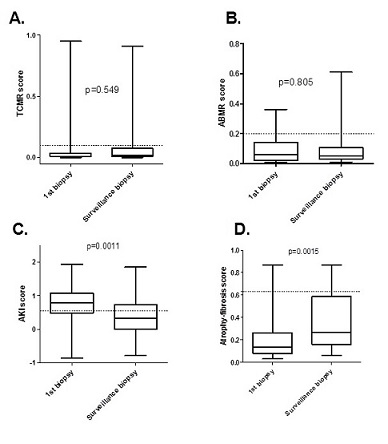Natural Course of Borderline Changes in Kidney Allografts: A MMDx Study
1Transplant Laboratory, IKEM, Prague, Czech Republic, 2ATAGC, University of Alberta, Edmonton, AB, Canada, 3Department of Pathology, IKEM, Prague, Czech Republic, 4Department of Nephrology, IKEM, Prague, Czech Republic
Meeting: 2020 American Transplant Congress
Abstract number: B-332
Keywords: Biopsy, Kidney transplantation, Rejection
Session Information
Session Name: Poster Session B: Acute Rejection
Session Type: Poster Session
Date: Saturday, May 30, 2020
Session Time: 3:15pm-4:00pm
 Presentation Time: 3:30pm-4:00pm
Presentation Time: 3:30pm-4:00pm
Location: Virtual
*Purpose: Molecular assessment of kidney allograft biopsies with Banff borderline changes (BL) category has showed only 30% of rejection phenotype in various post-transplant follow-up and natural course of the disease remains unclear.
*Methods: Using Molecular Microscope Diagnostic System (MMDx) series of molecular phenotypes in 46 first (median 13 POD) indication biopsies with a Banff BL category and subsequent 3M follow-up biopsies were analyzed. All BL findings were treated by steroid pulses. To evaluate risks for MMDx rejection scores at 3M, ROC analyses and binary regressions were performed.
*Results: Histological diagnosis of Banff BL in indication biopsies was interpreted by MMDx in 74% as no rejection, in 9% cases as T cell-mediated rejection (TCMR); in 13% as antibody-mediated rejection (ABMR), and in 4% as mixed rejection. Early BL biopsies exhibited significant both inflammation and acute kidney injury (72.6% and 66.7% respectively) while atrophy-fibrosis accounted only for 7.8% cases. 3M follow-up biopsies were interpreted by MMDx in 80% as no rejection, in 9% cases as TCMR, and in 11% as mixed rejection. In comparison to first biopsy, 3M follow up biopsies showed not significant decrease of inflammation (p=0.113) and significant decrease of acute kidney injury (p=0.0011) while atrophy-fibrosis increase (p=0.0015). Neither TCMR (p=0.549) nor ABMR score (p=0.805) decreased significantly from the first to 3M follow up biopsies (Figure 1). The most significant predictor of MMDx rejection scores at 3M follow up biopsies was higher MMDx score for tubulitis in indication biopsies (AUC=0.839, p=0.002, 88.9% sensitivity and 70.3% specificity). Multivariate binary regression model retained higher MMDx tubulitis score in the first biopsy as the only significant predictor of MMDx rejection at 3M (OR=15.9, p=0.016) while adjusting for inflammation score.
Figure 1 MMDx scores for TCMR (A), ABMR (B), acute kidney injury (AKI) (C) and atrophy fibrosis (D) in the 1st indication biopsy with borderline changes and subsequent surveillance biopsy at 3 months.
*Conclusions: MMDx assessment of early indication biopsies classified as Banff BL category showed in 20% molecular patterns of rejection that persisted to 3 months despite steroid treatment. Therefore, borderline should not be automatically treated as TCMR.
To cite this abstract in AMA style:
Hruba P, Madill-Thomsen KS, Mackova M, Maluskova J, Honsova E, Slatinska J, Halloran PF, Viklicky O. Natural Course of Borderline Changes in Kidney Allografts: A MMDx Study [abstract]. Am J Transplant. 2020; 20 (suppl 3). https://atcmeetingabstracts.com/abstract/natural-course-of-borderline-changes-in-kidney-allografts-a-mmdx-study/. Accessed December 17, 2025.« Back to 2020 American Transplant Congress

